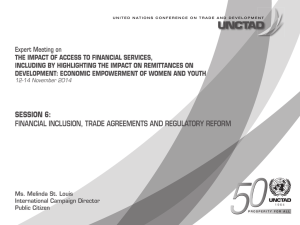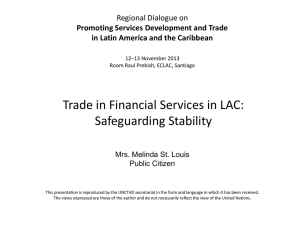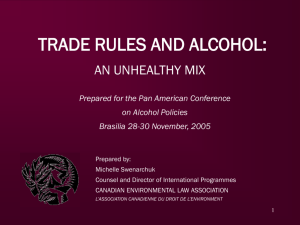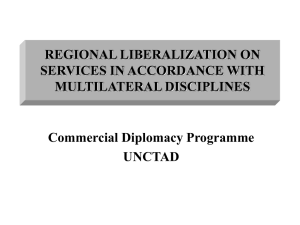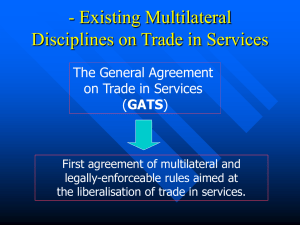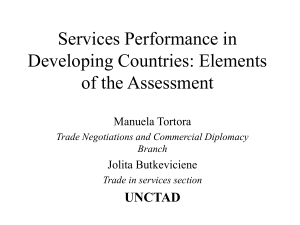Theory of International Trade in Services
advertisement
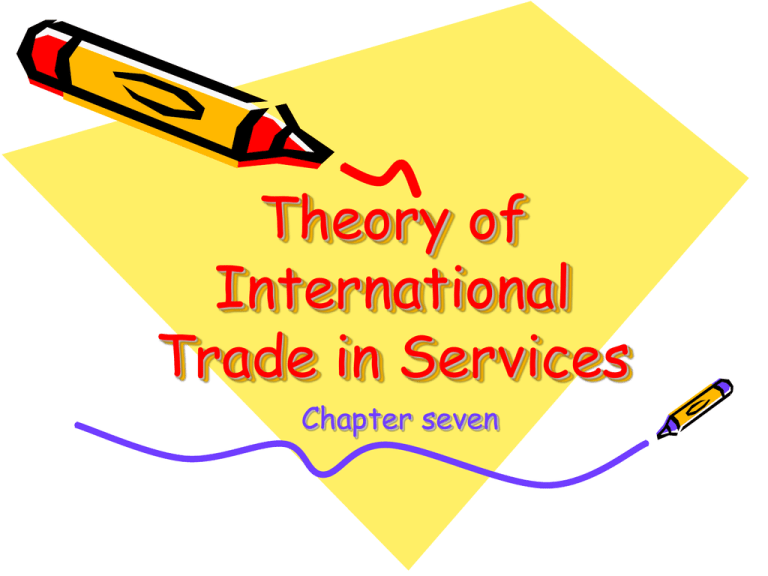
Theory of International Trade in Services Chapter seven Learning objective: • learn about the brief history, characteristics, main contents of GATS; • its key limitations and follow-up negotiations; • get to know the regional agreements on trade in services. 7.Introduction to General Agreement on Trade in Services 7.1 Background of GATS birth 7.1.1Liberalization of service trade proposed Developed country Developing country Led by the United States, developed countries actively propose the liberalization in service trade. • Why do the United States proposed the liberalization? • • 1) The pressure from the transnational corporations • 2) The desire to promote American interests in service trade and international investment. • What’s the attitude for the developing country? Oppose support 7.1.2Main purpose and basic rules of GATS • Main purpose of GATS • The main purpose of GATS is to extend global service trade under the condition of transparency and gradual liberalization by setting up multilateral rules in service trade • Basic rules of GATS 1 Most Favoured Nation Treatment 2 National Treatment 3 Transparency 4 Market Access • 7.2 Review on General Agreement on Trade in Services • 7.2.1. Structure and Characteristics of GATS(结构与特点) • (1)Structure of GATS(结构) • (2)Characteristics of GATS • 1) GATS follows and uses the basic principle and spirit of GATT for reference. • 2) GATS formulates respectively the general and special obligations. • 3) Large amount of specific regulations and concrete promises need to be negotiated and defined further. • • • • 7.2.2 Contents of GATS (1)Preface(序言) (2)Main Portion(主体) (3)Appendix of GATS(GATS附录) Main portion • 1) Range and definition of service trade • 2) Regular duty of each member • 3) Special responsibility undertaken 4)Gradual liberalization • 5) Regulation items • 6) Final clauses Definition of service trade • ① Cross-border supply (跨境交付方式) ② Consumption Abroad(境外消费) • ③ Commercial Presence(商业存在) ④ Movement of natural person (自然 人流动) • 7.3. Main Limitation and Follow-up Negotiations of GATS • 7.3.1Main Limitation of GATS (GATS的主要局限) • (1)Unbalance of Benefits Between Developed and Developing Countries (2)Less Binding Force in Trade Principle • (3)Unpleasant Result of concession • 7.3.2Further Negotiations of GATS (GATS的后续谈判) • (1)Negotiations on improvement of framework agreement (完善框架协议 的谈判) • 1) Emergency safeguard in service industry (服务业紧急保障问题) • 2) Subsidy for service industry (服务 业补贴问题) • 3) Government procurement (政府采 购问题) • 7.4.Regional Agreements on Service Trade (服务贸易的区域 性协议) • 7.4.1. Service Trade Agreement of EEC(欧盟服务贸易协议) • (1)Service Trade Agreement Inside EEC(欧盟内部的服务贸易协议)1) Free movement of personnel (人员的自由流动) • 2) Financial Service(金融服务) • 3) Transportation Service(运输服务) • 4) Telecom Service(电信服务) • (2)EEC Agreement on Foreign Trade in Services(欧盟对外服务贸易协议) • 7.4.2 Agreement on Service Trade in North-American Free Trade Area(北美自由贸易区的服务贸易协议) • (1)Finance(金融业) • (2)Telecommunication(电信业) (3)Other Services (其他服务业) Home work 1. What is the main frame of the General Agreement on Trade in Services? 2. What is the principle of the General Agreement on Trade in Services? 3. What are the main cores and principles for China to participate in the General Agreement on Trade in Services?
